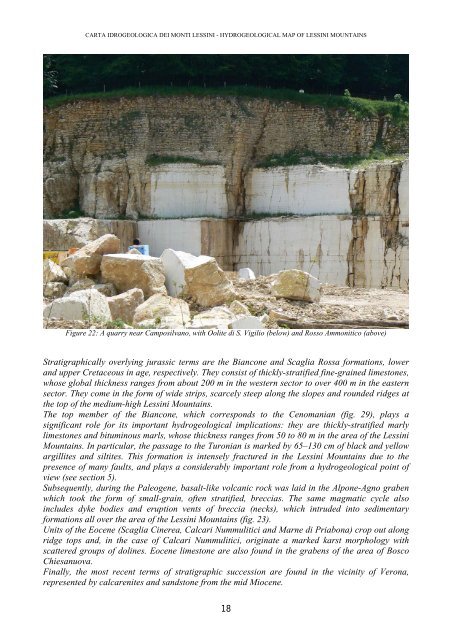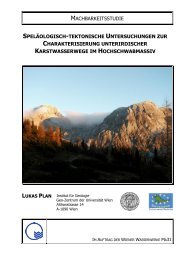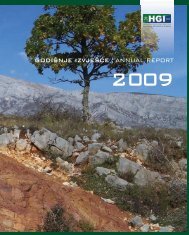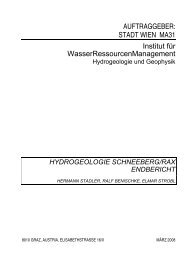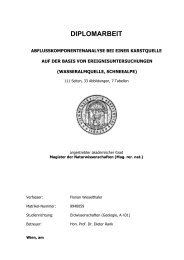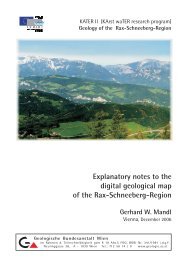HYDROGEOLOGICAL MAP OF LESSINI MOUNTAINS ... - CC-WaterS
HYDROGEOLOGICAL MAP OF LESSINI MOUNTAINS ... - CC-WaterS
HYDROGEOLOGICAL MAP OF LESSINI MOUNTAINS ... - CC-WaterS
You also want an ePaper? Increase the reach of your titles
YUMPU automatically turns print PDFs into web optimized ePapers that Google loves.
CARTA IDROGEOLOGICA DEI MONTI <strong>LESSINI</strong> - <strong>HYDROGEOLOGICAL</strong> <strong>MAP</strong> <strong>OF</strong> <strong>LESSINI</strong> <strong>MOUNTAINS</strong><br />
Figure 22: A quarry near Camposilvano, with Oolite di S. Vigilio (below) and Rosso Ammonitico (above)<br />
Stratigraphically overlying jurassic terms are the Biancone and Scaglia Rossa formations, lower<br />
and upper Cretaceous in age, respectively. They consist of thickly-stratified fine-grained limestones,<br />
whose global thickness ranges from about 200 m in the western sector to over 400 m in the eastern<br />
sector. They come in the form of wide strips, scarcely steep along the slopes and rounded ridges at<br />
the top of the medium-high Lessini Mountains.<br />
The top member of the Biancone, which corresponds to the Cenomanian (fig. 29), plays a<br />
significant role for its important hydrogeological implications: they are thickly-stratified marly<br />
limestones and bituminous marls, whose thickness ranges from 50 to 80 m in the area of the Lessini<br />
Mountains. In particular, the passage to the Turonian is marked by 65–130 cm of black and yellow<br />
argillites and siltites. This formation is intensely fractured in the Lessini Mountains due to the<br />
presence of many faults, and plays a considerably important role from a hydrogeological point of<br />
view (see section 5).<br />
Subsequently, during the Paleogene, basalt-like volcanic rock was laid in the Alpone-Agno graben<br />
which took the form of small-grain, often stratified, breccias. The same magmatic cycle also<br />
includes dyke bodies and eruption vents of breccia (necks), which intruded into sedimentary<br />
formations all over the area of the Lessini Mountains (fig. 23).<br />
Units of the Eocene (Scaglia Cinerea, Calcari Nummulitici and Marne di Priabona) crop out along<br />
ridge tops and, in the case of Calcari Nummulitici, originate a marked karst morphology with<br />
scattered groups of dolines. Eocene limestone are also found in the grabens of the area of Bosco<br />
Chiesanuova.<br />
Finally, the most recent terms of stratigraphic succession are found in the vicinity of Verona,<br />
represented by calcarenites and sandstone from the mid Miocene.<br />
18


